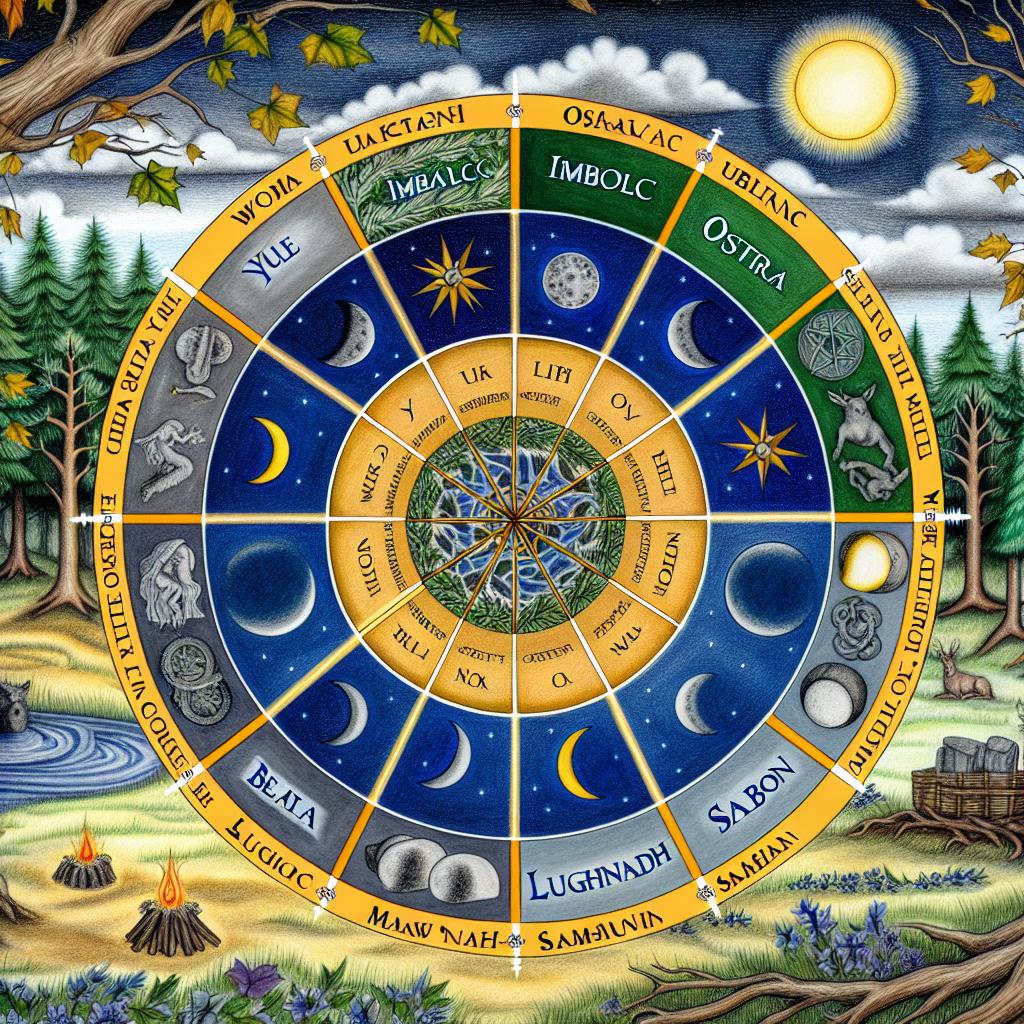
The Wheel of the Year in Wicca
The Wheel of the Year is a fundamental concept in the Wiccan tradition, representing the cyclical progression of the seasons and the ongoing cycle of life, death, and rebirth. This concept consists of a series of eight festivals, collectively known as Sabbats, which are celebrated by Wiccans to honor the passage of seasons and the Earth’s journey around the Sun.
Origins and Structure
The festivals that structure the Wheel of the Year have their origins in ancient agricultural and pagan traditions. These Sabbats are divided into the Greater Sabbats, which are the four cross-quarter days, and the Lesser Sabbats, which coincide with the solstices and equinoxes. The incorporation of these festivals into Wicca, a modern pagan religion, exemplifies a fusion of historical traditions with contemporary practices.
The Lesser Sabbats
The Lesser Sabbats take place during the solstices and equinoxes, serving as the astronomical turning points of the year.
Yule occurs on the Winter Solstice and signifies the rebirth of the Sun, marking the point when days begin to lengthen once more. This celebration is often associated with the return of light and hope following the shortest day of the year.
Ostara, celebrated during the Spring Equinox, marks the balance between darkness and light, symbolizing a period of equilibrium and renewal. It represents a time when nature awakens and life begins to bloom anew.
Litha, observed on the Summer Solstice, is the year’s longest day. This festival celebrates fertility, growth, and the culmination of sunlight, paying tribute to the abundance of nature in full bloom.
Mabon, which falls during the Autumn Equinox, is a moment of thanksgiving for the harvest. It represents a time of balance between day and night as the year begins its descent into winter, focusing on gratitude for the year’s bounty.
The Greater Sabbats
The Greater Sabbats are cross-quarter days positioned between the solstices and equinoxes.
Imbolc is celebrated on February 1st or 2nd, marking the midpoint between winter and spring. This festival symbolizes the awakening of the Earth, showcasing the hope and promise of renewal and rebirth as the icy grip of winter slowly loosens.
Beltane, occurring on May 1st, is a festival that celebrates fertility and the burgeoning growth of the natural world. It is associated with fire rituals and symbols of passion and vitality, emphasizing life and abundance.
Lughnasadh, also known as Lammas, takes place on August 1st. It is the first of three harvest festivals, celebrating the initial fruits of the land. This Sabbat honors the hard work and dedication required to achieve a successful harvest and the sustenance it provides.
Samhain, occurring on October 31st, is often considered the Wiccan New Year. It serves as a time to honor ancestors and reflect on the end of the harvest season, marking a period of introspection and connection with the spirit world.
The Role of the Wheel of the Year in Wiccan Practice
Within Wiccan practice, the Wheel of the Year offers a framework that allows adherents to connect with nature’s cyclical rhythms. It acts as a guide for aligning personal spiritual growth with the Earth’s natural cycles. By participating in rituals, meditations, and communal gatherings, followers of Wicca honor these festivals, fostering a deeper appreciation of nature’s interconnectedness and continuity.
As each Sabbat comes around, Wiccans engage in a variety of practices that reflect the significance of the season. For example, during Yule, practitioners might light candles to symbolize the returning light, while at Beltane, they might engage in dance or fire rituals to express the exuberance of life. These activities, while varied, are united in their goal of connecting the practitioner with the Earth and its natural rhythms.
Understanding these seasonal transformations and participating in related ceremonies cultivate a broader comprehension of the relationship between humanity, the environment, and the cosmos. Celebrations and interpretations of the Wheel of the Year may vary among individual practitioners and covens, yet it remains a crucial aspect of Wiccan spirituality. This cycle reflects the bonds that link humankind with the environment, guiding adherents in their spiritual journeys.
The Wheel of the Year acts as a vital spiritual calendar within Wicca, reminding practitioners of the ever-changing nature of the world. It encapsulates the themes of growth, decline, death, and rebirth, encouraging Wiccans to live in harmony with the Earth’s cycles. As a deeply symbolic and spiritual practice, it empowers individuals to honor their connection to nature and find spiritual meaning in the changing seasons.
For those seeking further insights into Wiccan practices and beliefs, additional resources are available to explore this rich tradition more deeply. Engaging with the Wheel of the Year invites a profound appreciation for the Earth’s rhythms, grounding practitioners in a timeless spiritual tradition that celebrates life in all its phases.
